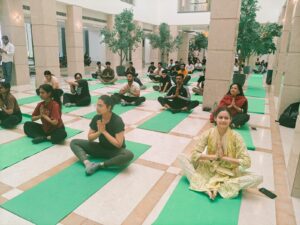Palak Mall*
The history of human civilization is adorned with a tapestry of colors, and the art of making natural dyes has played an integral role in this vibrant heritage. The ancient origins of this craft can be traced back to accidental discoveries when early humans stumbled upon the transformative power of berries and fruits as color sources. Over time, the knowledge of natural dyeing has been preserved and documented in ancient Indian texts like the Vedas and Arthasastra of Kautilya. Among the regions that still embrace this ancient practice today is the city of Amer, located in the culturally rich state of Rajasthan, India. In Amer, the art of making natural dyes has not only survived the passage of time but continues to thrive, despite certain traditional beliefs that restrict its transfer to female heirs. This article delves into the enduring practice of natural dye-making in Amer and its diverse applications in the realm of textiles.
Historical Roots: From Accidental Discoveries to Artisanal Knowledge
The origins of natural dyeing are as old as human history itself. Early humans, immersed in nature, chanced upon the transformative power of certain berries, fruits, and plant matter to produce vivid colors. These accidental discoveries marked the dawn of an art form that would captivate generations to come. As civilizations advanced, knowledge of natural dyeing became more systematic and found its place in ancient Indian texts like the Vedas and the Arthasastra, authored by the renowned strategist Kautilya.
Amer: The Custodian of Ancient Dye-Making
Nestled in the majestic land of Rajasthan, Amer is a city steeped in history and traditions. Amidst the royal grandeur and timeless architecture, the city houses artisans who have inherited the legacy of natural dye-making from their forefathers. This craft has become an inseparable part of Amer’s cultural identity. Amer’s commitment to upholding this timeless craft reflects not only a profound connection to its heritage but also a dedication to sustaining the unique identity that natural dyes bring to the world of textiles and art. As the sun sets over the majestic Amer Fort, the colors of history continue to breathe life into the present, perpetuating an artistic heritage that has withstood the sands of time.
Tradition and Taboos: The Challenge of Passing the Torch
While the practice of natural dye-making thrives in Amer, it faces the challenge of traditional beliefs. In certain households, there exists an age-old notion that restrains the knowledge of dye-making from being passed on to daughters. This belief stems from the fear that the daughter, upon marriage, will take this invaluable knowledge with her to her new home. Despite such taboos, dedicated artisans and cultural enthusiasts are taking strides to preserve and perpetuate this art by training interested individuals, irrespective of gender
Textiles: A Canvas of Natural Hues

The art of natural dye-making in Amer finds its most resplendent application in textiles. The vibrant colors derived from a variety of plant sources lend an organic and earthy charm to textiles like sarees, kurtas, and blankets. Artisans infuse these fabrics with hues that evoke a sense of connection to nature and history, creating timeless pieces cherished by locals and tourists alike.
These textiles, be it the elegant sarees that drape gracefully or the comfortable kurtas that exude charm, carry a story within their fibers. The artisans of Amer infuse these fabrics with the depth of their knowledge and the passion for their craft, resulting in exquisite masterpieces that transcend fashion trends and stand the test of time.
The allure of natural dyes lies not only in their captivating hues but also in their eco-friendly and sustainable nature. Unlike synthetic dyes, which often involve harmful chemicals and pollutants, natural dyes are derived from renewable sources, leaving behind a minimal ecological footprint. This aspect has garnered increasing appreciation from conscientious consumers and environmentally conscious designers alike.
In Amer, the legacy of natural dye-making is not merely a traditional craft but a way of life. It symbolizes a deep respect for nature’s gifts and a commitment to preserving cultural heritage. The artisans of Amer take pride in their role as custodians of this ancient knowledge, passing it on through generations to ensure that the vibrant threads of tradition continue to weave their magic into the fabric of time.
As the world embraces sustainable practices and seeks to forge a harmonious relationship with the environment, the art of making natural dyes gains newfound admiration and relevance. It serves as a shining example of how age-old wisdom can coexist harmoniously with modern sensibilities, offering a pathway to a more eco-conscious and culturally rich future.
Amer Fort: Where History Meets Colors

The iconic Amer Fort, a symbol of architectural brilliance, is not only a testament to the grandeur of the bygone era but also a canvas painted with natural dyes. The stunning colors adorning the walls of this majestic fortress are a testament to the enduring art of natural dye-making. Tourists from around the world marvel at the beauty of these colors that have withstood the test of time.
The art of making natural dyes is a profound reflection of human creativity and a testament to the enduring connection between humanity and nature. From its accidental origins to the carefully documented practices in ancient texts, this age-old craft has stood the test of time and continues to flourish in Amer, Rajasthan. As the custodians of this ancient tradition strive to preserve its essence, the vibrant colors created through natural dyes continue to breathe life into textiles and monuments alike. The art of natural dye-making in Amer is not only a celebration of heritage but a powerful reminder of the beauty and sustainability that nature bestows upon us.
(* Student, M A, Journalism and Mass Communication )





